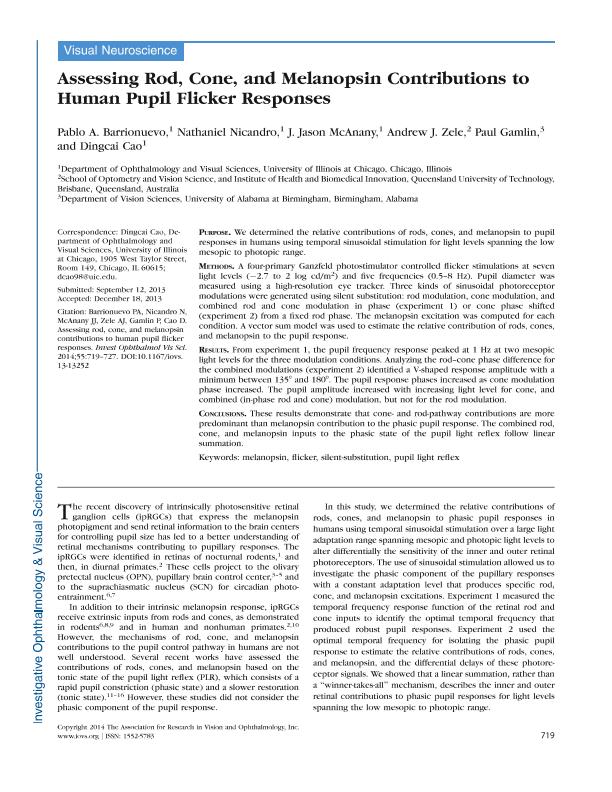Mostrar el registro sencillo del ítem
dc.contributor.author
Barrionuevo, Pablo Alejandro

dc.contributor.author
Nicandro, Nathaniel
dc.contributor.author
McAnany, J. Jason
dc.contributor.author
Zele, Andrew J.
dc.contributor.author
Gamlin, Paul
dc.contributor.author
Cao, Dingcai
dc.date.available
2017-01-26T19:38:08Z
dc.date.issued
2014-02
dc.identifier.citation
Barrionuevo, Pablo Alejandro; Nicandro, Nathaniel; McAnany, J. Jason; Zele, Andrew J.; Gamlin, Paul; et al.; Assessing Rod, Cone, and Melanopsin Contributions to Human Pupil Flicker Responses; Association for Research in Vision and Ophthalmology; Investigative Ophthalmology & Visual Science; 55; 2; 2-2014; 719-727
dc.identifier.issn
0146-0404
dc.identifier.uri
http://hdl.handle.net/11336/12007
dc.description.abstract
Purpose: To determine the relative contributions of rods, cones and melanopsin to pupil responses in humans using temporal sinusoidal stimulation for light levels spanning the low mesopic to photopic range. Methods: A four-primary Ganzfeld photostimulator controlled flicker stimulations at seven light levels (-2.7 to 2 log cd/m2) and five frequencies (0.5 to 8Hz). Pupil diameter was measured using a high-resolution eyetracker. Three kinds of sinusoidal photoreceptor modulations were generated using silent substitution: 1) rod modulation, 2) cone modulation, and 3) combined rod and cone modulation in phase (Experiment 1) or phase shifted (Experiment 2) from a fixed rod phase. The melanopsin excitation was computed for each condition. A vector sum model was used to estimate the relative contribution of rods, cones and melanopsin to the pupil response. Results: From Experiment 1, the pupil frequency response peaked at 1Hz at two mesopic light levels for the three modulation conditions. Analyzing the rod-cone phase difference for the combined modulations (Experiment 2) identified a V-shaped response amplitude with a minimum between 135° and 180°. The pupil response phases increased as cone modulation phase increased. The pupil amplitude increased with increasing light level for cone and combined in-phase rod and cone modulation, but not for the rod modulation. Conclusions: These results demonstrate that cone- and rod-pathway contributions are more predominant than melanopsin contribution to the phasic pupil response. The combined rod, cone and melanopsin inputs to the phasic state of the pupil light reflex follow linear summation.
dc.format
application/pdf
dc.language.iso
eng
dc.publisher
Association for Research in Vision and Ophthalmology

dc.rights
info:eu-repo/semantics/openAccess
dc.rights.uri
https://creativecommons.org/licenses/by-nc-sa/2.5/ar/
dc.subject
Melanopsin
dc.subject
Flicker
dc.subject
Silent-Substitution
dc.subject
Pupil Light Reflex
dc.subject.classification
Neurociencias

dc.subject.classification
Medicina Básica

dc.subject.classification
CIENCIAS MÉDICAS Y DE LA SALUD

dc.title
Assessing Rod, Cone, and Melanopsin Contributions to Human Pupil Flicker Responses
dc.type
info:eu-repo/semantics/article
dc.type
info:ar-repo/semantics/artículo
dc.type
info:eu-repo/semantics/publishedVersion
dc.date.updated
2017-01-24T18:32:04Z
dc.identifier.eissn
1552-5783
dc.journal.volume
55
dc.journal.number
2
dc.journal.pagination
719-727
dc.journal.pais
Estados Unidos

dc.journal.ciudad
Rockville
dc.description.fil
Fil: Barrionuevo, Pablo Alejandro. Consejo Nacional de Investigaciones Científicas y Técnicas. Centro Científico Tecnológico Tucuman. Instituto de Investigacion En Luz, Ambiente y Vision; Argentina. University Of Illinois; Estados Unidos
dc.description.fil
Fil: Nicandro, Nathaniel. University Of Illinois; Estados Unidos
dc.description.fil
Fil: McAnany, J. Jason. University Of Illinois; Estados Unidos
dc.description.fil
Fil: Zele, Andrew J.. University Of Queensland; Australia
dc.description.fil
Fil: Gamlin, Paul. University Of Alabama At Birmingahm; Estados Unidos
dc.description.fil
Fil: Cao, Dingcai. University Of Illinois; Estados Unidos
dc.journal.title
Investigative Ophthalmology & Visual Science

dc.relation.alternativeid
info:eu-repo/semantics/altIdentifier/url/http://iovs.arvojournals.org/article.aspx?articleid=2189826
dc.relation.alternativeid
info:eu-repo/semantics/altIdentifier/doi/http://dx.doi.org/10.1167/iovs.13-13252
dc.relation.alternativeid
info:eu-repo/semantics/altIdentifier/url/https://www.ncbi.nlm.nih.gov/pmc/articles/PMC3915766/
Archivos asociados
